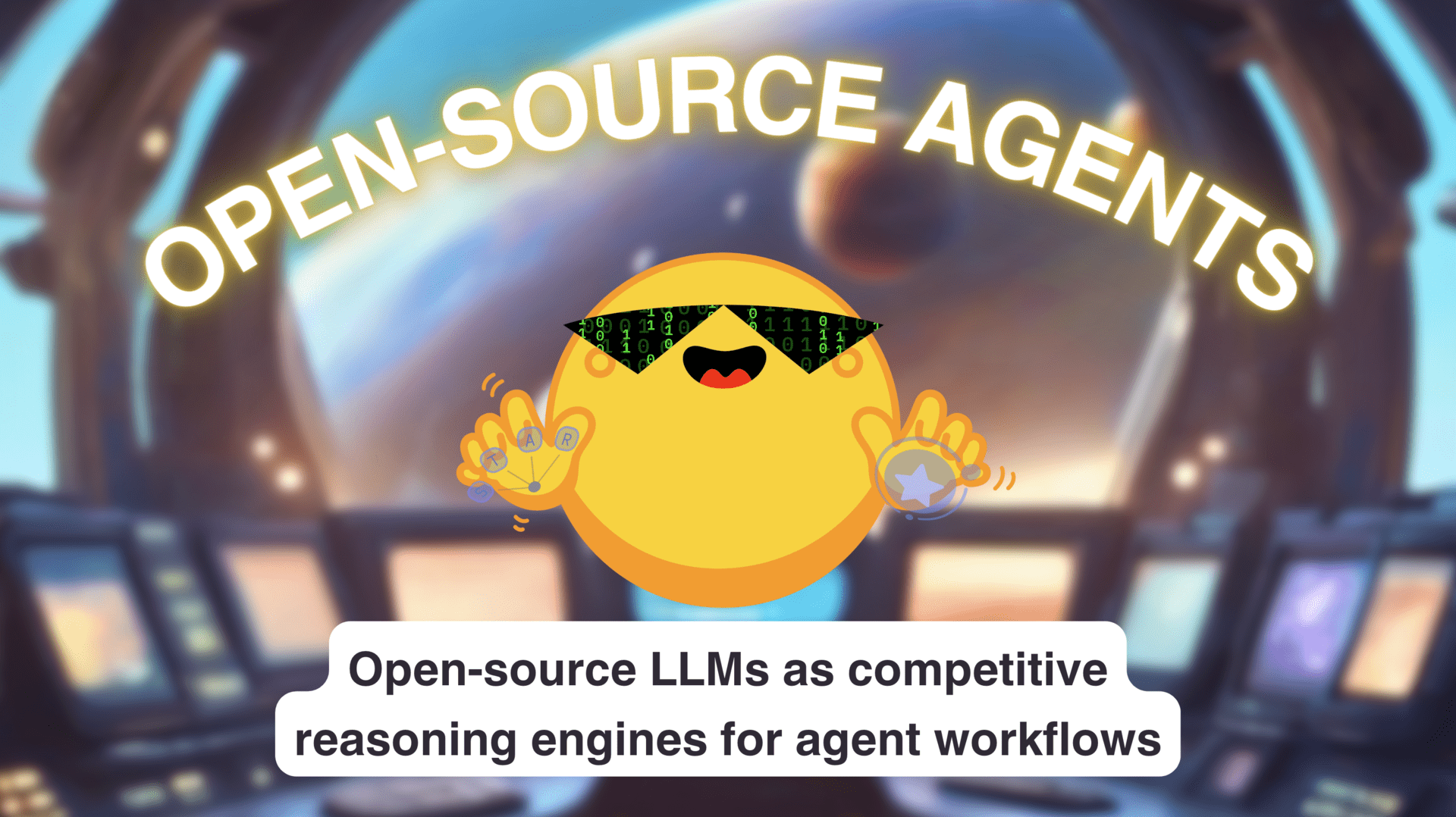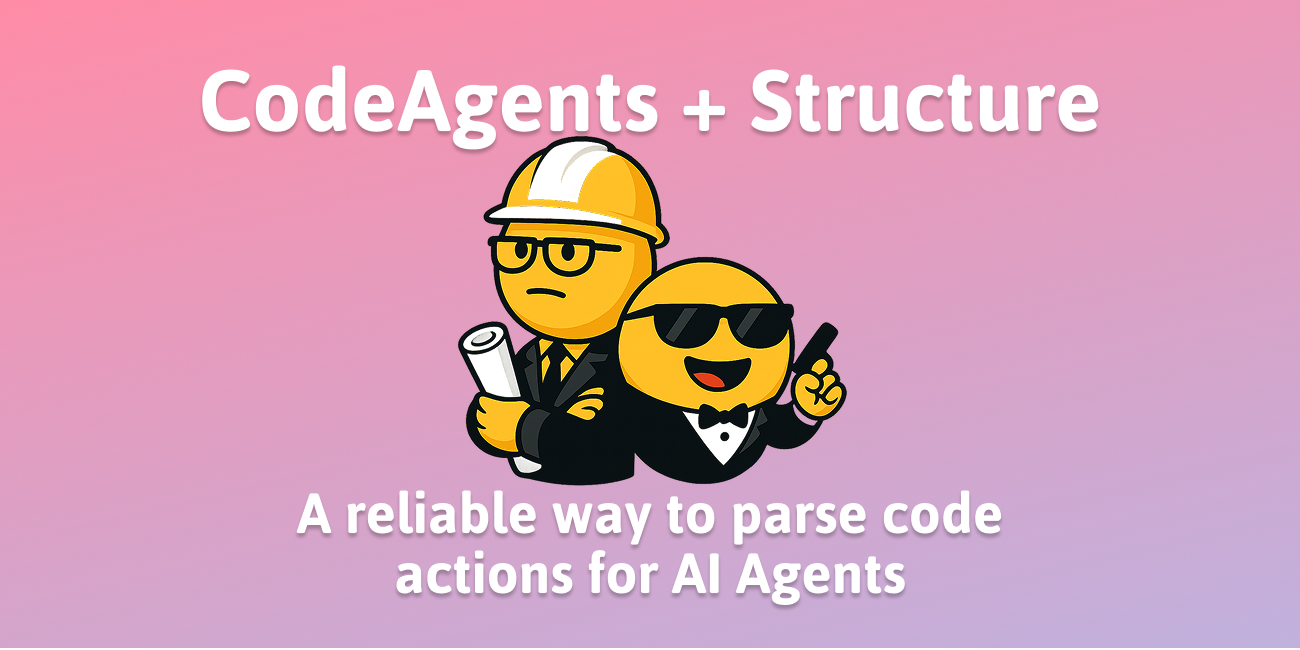呼叫許可:Transformers Agents 2.0 介紹
TL;DR
我們正在釋出 Transformers Agents 2.0!
⇒ 🎁 在我們現有的智慧體型別之上,我們引入了兩種新智慧體,它們**可以根據過去的觀察結果進行迭代以解決複雜任務**。
⇒ 💡 我們的目標是讓程式碼**清晰、模組化,並讓最終的提示和工具等通用屬性透明可見**。
⇒ 🤝 我們增加了**共享選項**,以促進社群智慧體的發展。
⇒ 💪 **極其高效能的新智慧體框架**,讓 Llama-3-70B-Instruct 智慧體在 GAIA 排行榜上超越了基於 GPT-4 的智慧體!
🚀 趕快嘗試一下,在 GAIA 排行榜上更上一層樓吧!
transformers.agents現已升級為獨立庫 smolagents!這兩個庫的 API 非常相似,因此切換很容易。請檢視 smolagents 介紹部落格。
目錄
什麼是智慧體?
大型語言模型 (LLM) 可以處理各種任務,但它們在邏輯、計算和搜尋等特定任務上常常遇到困難。當在這些它們表現不佳的領域被提示時,它們經常無法生成正確的答案。
克服這一弱點的一種方法是建立一個**智慧體**,它只是一個由 LLM 驅動的程式。智慧體透過**工具**獲得能力,以幫助其執行操作。當智慧體需要特定技能來解決特定問題時,它會依賴其工具箱中合適的工具。
因此,當智慧體在解決問題時需要特定技能時,它只需依賴其工具箱中合適的工具即可。
實驗表明,智慧體框架通常表現非常好,在多項基準測試中取得了最先進的效能。例如,請檢視HumanEval 的頂級提交:它們都是智慧體系統。
Transformers Agents 的方法
構建智慧體工作流是複雜的,我們認為這些系統需要很高的清晰度和模組化。一年前我們釋出了 Transformers Agents,現在我們正在加倍努力實現我們的核心設計目標。
我們的框架力求
- 透過簡潔實現清晰:我們儘可能減少抽象。簡單的錯誤日誌和可訪問的屬性讓您可以輕鬆檢查正在發生的事情,並提供更高的清晰度。
- 模組化:我們傾向於提供構建塊,而不是完整、複雜的特徵集。您可以自由選擇最適合您專案的構建塊。
- 例如,由於任何智慧體系統都只是由 LLM 引擎驅動的載體,我們決定在概念上將兩者分離,這使您可以用任何底層 LLM 建立任何智慧體型別。
最重要的是,我們有**共享功能**,讓您可以站在巨人的肩膀上!
主要元素
Tool:這是讓您使用工具或實現新工具的類。它主要由一個可呼叫前向方法組成,該方法執行工具操作,以及一組幾個基本屬性:name、descriptions、inputs和output_type。這些屬性用於為工具動態生成使用手冊並將其插入到 LLM 的提示中。Toolbox:它是一組提供給智慧體的工具,作為解決特定任務的資源。出於效能考慮,工具箱中的工具已經例項化並準備就緒。這是因為某些工具需要時間進行初始化,因此通常最好重用現有工具箱並只交換一個工具,而不是在每次智慧體初始化時從頭開始重新構建一組工具。CodeAgent:一個非常簡單的智慧體,將其操作生成為單個 Python 程式碼塊。它無法根據先前的觀察進行迭代。ReactAgent:ReAct 智慧體遵循思考 ⇒ 行動 ⇒ 觀察的迴圈,直到它們解決了任務。我們提供了兩類 ReactAgentReactCodeAgent將其動作生成為 python 程式碼塊。ReactJsonAgent將其動作生成為 JSON 塊。
檢視文件以瞭解如何使用每個元件!
智慧體在底層是如何工作的?
本質上,智慧體的作用是“允許 LLM 使用工具”。智慧體有一個關鍵的agent.run()方法,它會:
- 以**特定提示**的形式向 LLM 提供工具使用資訊。這樣,LLM 就可以選擇要執行的工具來解決任務。
- **解析** LLM 輸出中的工具呼叫(可以是程式碼、JSON 格式或任何其他格式)。
- **執行**呼叫。
- 如果智慧體被設計為在先前輸出上進行迭代,它會**保留一個帶有先前工具呼叫和觀察的記憶體**。這個記憶體的粒度可以根據你希望它的長期性而或多或少地精細。

有關智慧體的更多一般背景資訊,您可以閱讀 Lilian Weng 的這篇優秀部落格文章,或我們早期關於使用 LangChain 構建智慧體的部落格文章。
要更深入地瞭解我們的包,請檢視智慧體文件。
示例用例
為了能夠提前體驗此功能,請首先從其main分支安裝transformers
pip install "git+https://github.com/huggingface/transformers.git#egg=transformers[agents]"
Agents 2.0 將在 5 月中旬釋出的 v4.41.0 版本中釋出。
自校正檢索增強生成
快速定義:檢索增強生成 (RAG) 是指“使用 LLM 回答使用者查詢,但答案基於從知識庫中檢索到的資訊”。它比使用普通或微調的 LLM 有許多優點:舉幾個例子,它允許將答案基於真實事實並減少胡編亂造,它允許為 LLM 提供特定領域的知識,並且它允許對知識庫資訊的訪問進行細粒度控制。
假設我們要執行 RAG,並且一些引數必須動態生成。例如,根據使用者查詢,我們可能希望將搜尋限制在知識庫的特定子集,或者我們可能希望調整檢索文件的數量。困難在於:如何根據使用者查詢動態調整這些引數?
好吧,我們可以透過讓我們的智慧體訪問這些引數來做到這一點!
讓我們設定這個系統。
執行下面這行命令來安裝所需的依賴項
pip install langchain sentence-transformers faiss-cpu
我們首先載入一個知識庫,我們希望在該知識庫上執行 RAG:該資料集是許多huggingface包的文件頁面的編譯,以 markdown 格式儲存。
import datasets
knowledge_base = datasets.load_dataset("m-ric/huggingface_doc", split="train")
現在我們透過處理資料集並將其儲存到向量資料庫中來準備知識庫,以供檢索器使用。我們將使用 LangChain,因為它具有出色的向量資料庫實用程式
from langchain.docstore.document import Document
from langchain.text_splitter import RecursiveCharacterTextSplitter
from langchain.vectorstores import FAISS
from langchain_community.embeddings import HuggingFaceEmbeddings
source_docs = [
Document(
page_content=doc["text"], metadata={"source": doc["source"].split("/")[1]}
) for doc in knowledge_base
]
docs_processed = RecursiveCharacterTextSplitter(chunk_size=500).split_documents(source_docs)[:1000]
embedding_model = HuggingFaceEmbeddings("thenlper/gte-small")
vectordb = FAISS.from_documents(
documents=docs_processed,
embedding=embedding_model
)
現在資料庫已準備就緒,讓我們構建一個基於它回答使用者查詢的 RAG 系統!
我們希望我們的系統根據查詢只從最相關的資訊源中進行選擇。
我們的文件頁面來自以下來源
>>> all_sources = list(set([doc.metadata["source"] for doc in docs_processed]))
>>> print(all_sources)
['blog', 'optimum', 'datasets-server', 'datasets', 'transformers', 'course',
'gradio', 'diffusers', 'evaluate', 'deep-rl-class', 'peft',
'hf-endpoints-documentation', 'pytorch-image-models', 'hub-docs']
我們如何根據使用者查詢選擇相關來源?
👉 讓我們將 RAG 系統構建為一個智慧體,它可以自由選擇其來源!
我們建立一個檢索器工具,智慧體可以使用它呼叫其選擇的引數
import json
from transformers.agents import Tool
from langchain_core.vectorstores import VectorStore
class RetrieverTool(Tool):
name = "retriever"
description = "Retrieves some documents from the knowledge base that have the closest embeddings to the input query."
inputs = {
"query": {
"type": "text",
"description": "The query to perform. This should be semantically close to your target documents. Use the affirmative form rather than a question.",
},
"source": {
"type": "text",
"description": ""
},
}
output_type = "text"
def __init__(self, vectordb: VectorStore, all_sources: str, **kwargs):
super().__init__(**kwargs)
self.vectordb = vectordb
self.inputs["source"]["description"] = (
f"The source of the documents to search, as a str representation of a list. Possible values in the list are: {all_sources}. If this argument is not provided, all sources will be searched."
)
def forward(self, query: str, source: str = None) -> str:
assert isinstance(query, str), "Your search query must be a string"
if source:
if isinstance(source, str) and "[" not in str(source): # if the source is not representing a list
source = [source]
source = json.loads(str(source).replace("'", '"'))
docs = self.vectordb.similarity_search(query, filter=({"source": source} if source else None), k=3)
if len(docs) == 0:
return "No documents found with this filtering. Try removing the source filter."
return "Retrieved documents:\n\n" + "\n===Document===\n".join(
[doc.page_content for doc in docs]
)
現在,建立一個利用此工具的智慧體就很容易了!
智慧體在初始化時需要以下引數
tools:智慧體可以呼叫的工具列表。llm_engine:為智慧體提供動力的 LLM。
我們的 llm_engine 必須是一個可呼叫物件,它以訊息列表為輸入並返回文字。它還需要接受一個 stop_sequences 引數,指示何時停止生成。為了方便起見,我們直接使用包中提供的 HfEngine 類來獲取一個呼叫我們 Inference API 的 LLM 引擎。
from transformers.agents import HfEngine, ReactJsonAgent
llm_engine = HfEngine("meta-llama/Meta-Llama-3-70B-Instruct")
agent = ReactJsonAgent(
tools=[RetrieverTool(vectordb, all_sources)],
llm_engine=llm_engine
)
agent_output = agent.run("Please show me a LORA finetuning script")
print("Final output:")
print(agent_output)
由於我們將智慧體初始化為ReactJsonAgent,它已自動獲得一個預設系統提示,該提示告訴LLM引擎逐步處理並將工具呼叫生成為JSON blob(您可以根據需要用您自己的提示模板替換此提示)。
然後,當其 .run() 方法啟動時,智慧體會負責呼叫 LLM 引擎、解析工具呼叫 JSON blob 並執行這些工具呼叫,所有這些都在一個迴圈中,只有當最終答案提供時才結束。
我們得到以下輸出
Calling tool: retriever with arguments: {'query': 'LORA finetuning script', 'source': "['transformers', 'datasets-server', 'datasets']"}
Calling tool: retriever with arguments: {'query': 'LORA finetuning script'}
Calling tool: retriever with arguments: {'query': 'LORA finetuning script example', 'source': "['transformers', 'datasets-server', 'datasets']"}
Calling tool: retriever with arguments: {'query': 'LORA finetuning script example'}
Calling tool: final_answer with arguments: {'answer': 'Here is an example of a LORA finetuning script: https://github.com/huggingface/diffusers/blob/dd9a5caf61f04d11c0fa9f3947b69ab0010c9a0f/examples/text_to_image/train_text_to_image_lora.py#L371'}
Final output:
Here is an example of a LORA finetuning script: https://github.com/huggingface/diffusers/blob/dd9a5caf61f04d11c0fa9f3947b69ab0010c9a0f/examples/text_to_image/train_text_to_image_lora.py#L371
我們可以看到自我糾正在起作用:智慧體首先嚐試限制來源,但由於缺乏相應的文件,它最終根本沒有限制來源。
我們可以透過檢查步驟 2 的日誌中的 LLM 輸出進行驗證:print(agent.logs[2]['llm_output'])
Thought: I'll try to retrieve some documents related to LORA finetuning scripts from the entire knowledge base, without any source filtering.
Action:
{
"action": "retriever",
"action_input": {"query": "LORA finetuning script"}
}
使用簡單的多智慧體設定🤝實現高效網頁瀏覽
在此示例中,我們希望構建一個智慧體並在 GAIA 基準測試(Mialon et al. 2023)上對其進行測試。GAIA 是一個極其困難的基準測試,大多數問題需要使用不同的工具進行多步推理。一個特別困難的要求是擁有一個強大的網頁瀏覽器,能夠導航到具有特定限制的頁面:使用網站的內部導航發現頁面,及時選擇特定文章……
網頁瀏覽需要深入子頁面並滾動瀏覽大量文字標記,這些標記對於更高層次的任務解決是不必要的。我們將網頁瀏覽子任務分配給一個專門的網頁瀏覽智慧體。我們為其提供了一些用於瀏覽網頁的工具和一個特定的提示(請檢視倉庫以查詢具體實現)。
定義這些工具超出了本篇帖子的範圍:但您可以檢視倉庫以查詢具體實現。
from transformers.agents import ReactJsonAgent, HfEngine
WEB_TOOLS = [
SearchInformationTool(),
NavigationalSearchTool(),
VisitTool(),
DownloadTool(),
PageUpTool(),
PageDownTool(),
FinderTool(),
FindNextTool(),
]
websurfer_llm_engine = HfEngine(
model="CohereForAI/c4ai-command-r-plus"
) # We choose Command-R+ for its high context length
websurfer_agent = ReactJsonAgent(
tools=WEB_TOOLS,
llm_engine=websurfer_llm_engine,
)
為了讓這個智慧體能夠被更高層次的任務解決智慧體呼叫,我們可以簡單地將其封裝在另一個工具中
class SearchTool(Tool):
name = "ask_search_agent"
description = "A search agent that will browse the internet to answer a question. Use it to gather informations, not for problem-solving."
inputs = {
"question": {
"description": "Your question, as a natural language sentence. You are talking to an agent, so provide them with as much context as possible.",
"type": "text",
}
}
output_type = "text"
def forward(self, question: str) -> str:
return websurfer_agent.run(question)
然後我們用這個搜尋工具初始化任務解決智慧體
from transformers.agents import ReactCodeAgent
llm_engine = HfEngine(model="meta-llama/Meta-Llama-3-70B-Instruct")
react_agent_hf = ReactCodeAgent(
tools=[SearchTool()],
llm_engine=llm_engine,
)
讓我們用以下任務執行智慧體
使用由 Marisa Alviar-Agnew 和 Henry Agnew 根據 CK-12 許可證在 LibreText 的《入門化學材料》中編譯的(2023 年 8 月 21 日)密度測量資料。我有一加侖蜂蜜和一加侖蛋黃醬,溫度均為 25C。我每次從一加侖蜂蜜中取出“一杯”蜂蜜。我需要取出多少次才能讓蜂蜜的重量小於蛋黃醬?假設容器本身的重量相同。
Thought: I will use the 'ask_search_agent' tool to find the density of honey and mayonnaise at 25C.
==== Agent is executing the code below:
density_honey = ask_search_agent(question="What is the density of honey at 25C?")
print("Density of honey:", density_honey)
density_mayo = ask_search_agent(question="What is the density of mayonnaise at 25C?")
print("Density of mayo:", density_mayo)
===
Observation:
Density of honey: The density of honey is around 1.38-1.45kg/L at 20C. Although I couldn't find information specific to 25C, minor temperature differences are unlikely to affect the density that much, so it's likely to remain within this range.
Density of mayo: The density of mayonnaise at 25°C is 0.910 g/cm³.
===== New step =====
Thought: I will convert the density of mayonnaise from g/cm³ to kg/L and then calculate the initial weights of the honey and mayonnaise in a gallon. After that, I will calculate the weight of honey after removing one cup at a time until it weighs less than the mayonnaise.
==== Agent is executing the code below:
density_honey = 1.42 # taking the average of the range
density_mayo = 0.910 # converting g/cm³ to kg/L
density_mayo = density_mayo * 1000 / 1000 # conversion
gallon_to_liters = 3.785 # conversion factor
initial_honey_weight = density_honey * gallon_to_liters
initial_mayo_weight = density_mayo * gallon_to_liters
cup_to_liters = 0.236 # conversion factor
removed_honey_weight = cup_to_liters * density_honey
===
Observation:
===== New step =====
Thought: Now that I have the initial weights of honey and mayonnaise, I'll try to calculate the number of cups to remove from the honey to make it weigh less than the mayonnaise using a simple arithmetic operation.
==== Agent is executing the code below:
cups_removed = int((initial_honey_weight - initial_mayo_weight) / removed_honey_weight) + 1
print("Cups removed:", cups_removed)
final_answer(cups_removed)
===
>>> Final answer: 6
✅ 答案是**正確**的!
測試我們的智慧體
讓我們試用一下我們的智慧體框架,並用它來對不同的模型進行基準測試!
以下所有實驗程式碼都可以在這裡找到。
LLM 引擎基準測試
agents_reasoning_benchmark 是一個小型但強大的推理測試,用於評估智慧體的效能。此基準測試已在我們之前的部落格文章中更詳細地使用和解釋過。
核心思想是,您與智慧體一起使用的工具選擇會極大地改變某些任務的效能。因此,此基準測試將使用的工具集限制為計算器和基本搜尋工具。我們從幾個可以使用這兩種工具解決的資料集中挑選了問題
- 來自HotpotQA的 30 個問題(Yang et al., 2018),用於測試搜尋工具的使用。
- 來自GSM8K的 40 個問題(Cobbe et al., 2021),用於測試計算器工具的使用。
- 來自GAIA的 20 個問題(Mialon et al., 2023),用於測試兩種工具在解決難題時的使用。
這裡我們嘗試了 3 種不同的引擎:Mixtral-8x7B、Llama-3-70B-Instruct 和 GPT-4 Turbo。

結果如上所示——為了更精確,取兩次完整執行的平均值。我們還測試了Command-R+和Mixtral-8x22B,但為了清晰起見,未顯示它們。
⇒ Llama-3-70B-Instruct 在開源模型中處於領先地位:它與 GPT-4 不相上下,而且由於 Llama 3 強大的編碼效能,它在 ReactCodeAgent 中表現尤其出色!
💡 比較基於 JSON 和基於程式碼的 React 智慧體很有趣:對於 Mixtral-8x7B 等效能較低的 LLM 引擎,基於程式碼的智慧體表現不如 JSON,因為 LLM 引擎經常無法生成高質量的程式碼。但基於程式碼的版本在與更強大的模型作為引擎配合時表現出色:根據我們的經驗,基於程式碼的版本甚至在 Llama-3-70B-Instruct 上優於 JSON。因此,我們在下一個挑戰中使用基於程式碼的版本:在完整的 GAIA 基準測試中進行測試。
使用多模態智慧體攀登 GAIA 排行榜
GAIA(Mialon et al., 2023)是一個極其困難的基準測試:您可以在上面的agent_reasoning_benchmark中看到,即使我們挑選了可以用 2 個基本工具解決的任務,模型也無法達到 50% 以上的效能。
現在我們希望在完整資料集上獲得分數,我們不再挑選問題。因此,我們必須涵蓋所有模態,這促使我們使用這些特定工具
SearchTool:上面定義的網路瀏覽器。TextInspectorTool:將文件作為文字檔案開啟並返回其內容。SpeechToTextTool:將音訊檔案轉錄為文字。我們使用基於distil-whisper的預設工具。VisualQATool:視覺分析影像。為此,我們使用了閃亮的新Idefics2-8b-chatty!
我們首先初始化這些工具(更多詳細資訊,請檢查倉庫中的程式碼)。
然後我們初始化我們的智慧體
from transformers.agents import ReactCodeAgent, HfEngine
TASK_SOLVING_TOOLBOX = [
SearchTool(),
VisualQATool(),
SpeechToTextTool(),
TextInspectorTool(),
]
react_agent_hf = ReactCodeAgent(
tools=TASK_SOLVING_TOOLBOX,
llm_engine=HfEngine(model="meta-llama/Meta-Llama-3-70B-Instruct"),
memory_verbose=True,
)
在完成 165 個問題所需的時間之後,我們將結果提交到 GAIA 排行榜,然後……🥁🥁🥁

⇒ 我們的智慧體排名第四:它擊敗了許多基於 GPT-4 的智慧體,現在是開源類別中的衛冕者!
結論
我們將在未來幾個月內繼續改進此軟體包。我們已經確定了開發路線圖中幾個令人興奮的方向
- 更多智慧體共享選項:目前您可以從 Hub 推送或載入工具,我們也將實現推送/載入智慧體。
- 更好的工具,特別是影像處理工具。
- 長期記憶管理。
- 多智慧體協作。
👉 去試試 Transformers Agents 吧!我們期待收到您的反饋和想法。
讓我們用更多的開源模型填滿排行榜頂部!🚀
transformers.agents現已升級為獨立庫 smolagents!這兩個庫的 API 非常相似,因此切換很容易。請檢視 smolagents 介紹部落格。

